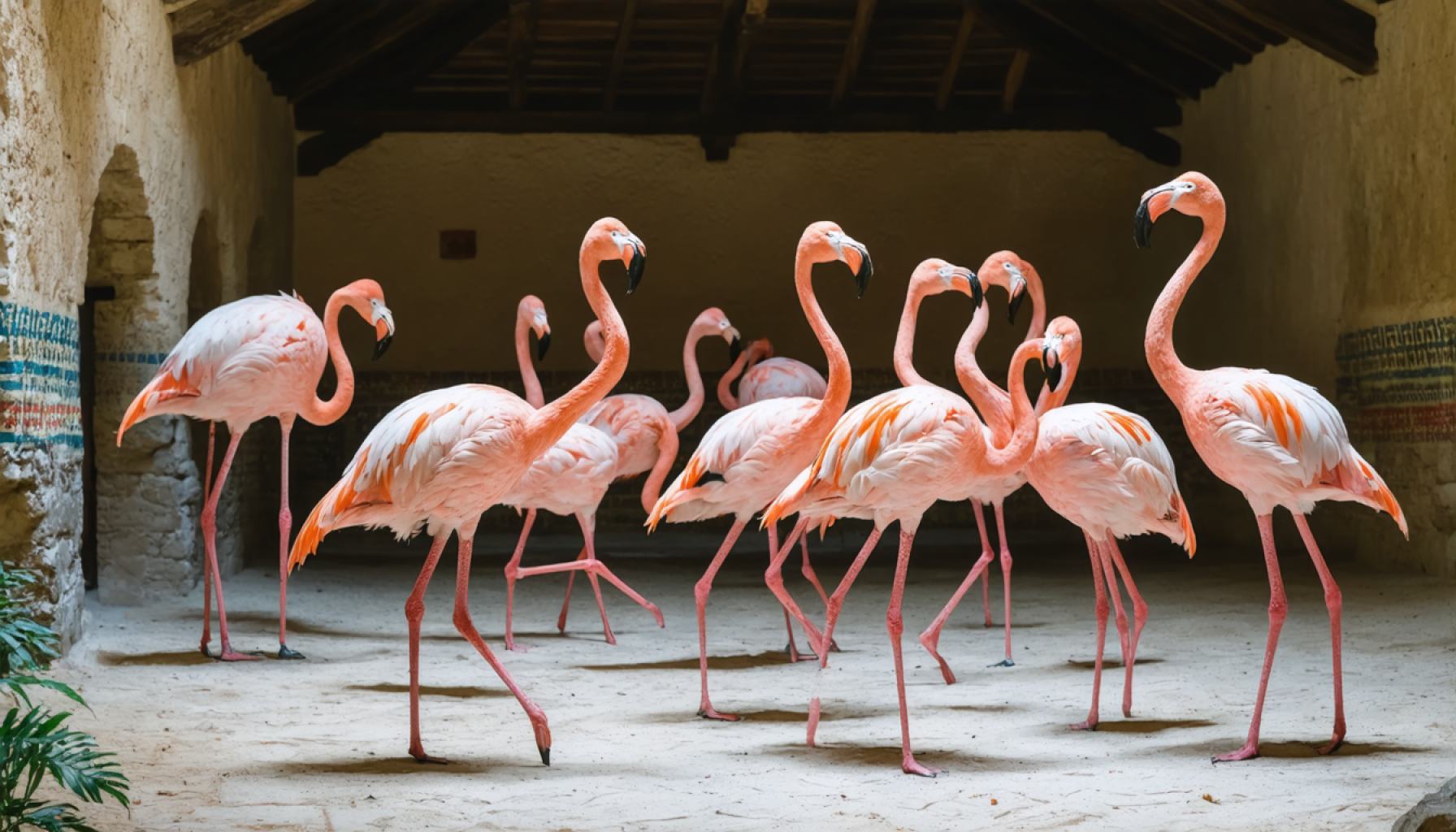
- Doñana is a Biosphere Reserve and World Heritage site, home to over 400 bird species and the Iberian lynx, merging biodiversity with local traditions.
- The Cave of Altamira in Cantabria, known as the Sistine Chapel of Paleolithic art, offers a glimpse into Ice Age life with realistic animal depictions.
- Playa de la Concha in San Sebastián, with its classic elegance, was historically favored by the European elite.
- Sevilla’s Alcázar and its Gothic cathedral reflect a rich history of Arabian and Renaissance influences.
- Mallorca’s Sierra de Tramuntana blends dramatic natural landscapes with preserved rustic village charm.
- Spain’s cultural landmarks offer an unparalleled tapestry of natural beauty and human history, inspiring global exploration and cultural appreciation.
The air is filled with vibrant color as flocks of flamingos soar gracefully over the marshes of Doñana, a shimmering mosaic of emerald greens and mirrored waters. Here, where the provinces of Huelva and Sevilla embrace, lies a world where biodiversity flourishes. Declared a Biosphere Reserve and World Heritage, Doñana serves as a sanctuary for over 400 avian species, including the elusive Iberian lynx, cementing its fame as a naturalist’s paradise. Its ecosystems, ranging from marshlands to pine forests, form a delicate equilibrium with local economic and cultural traditions like rice cultivation and cattle grazing.
Elsewhere in Spain, a different kind of wonder awaits. Deep in the heart of Cantabria, the Cave of Altamira hides ancient whispers of the past. Dubbed the Sistine Chapel of Paleolithic art, it was once home to our Ice Age ancestors. The walls are adorned with vibrant depictions of bison, horses, and other fauna, crafted with extraordinary realism thousands of years ago. While the original site is closed to preserve these treasures, a nearby museum offers a faithful reproduction, inviting visitors to step back into prehistory.
The golden sands of Playa de la Concha in San Sebastián offer a glimpse into the glamour of the past. This sweeping crescent of sand, framed by the comforting emerald of Santa Clara Island, once enchanted the European elite. Stroll along its iconic white iron railings or dive into its calm waters—the serene beauty remains timeless.
From the grandeur of nature to the elegance of human creation, the Alcázar of Sevilla tells stories of Arabian fortitude and Renaissance opulence. As one of the oldest royal palaces in Europe still in use, its gardens and halls resonate with the echoes of history. Just steps away, the city’s Gothic cathedral boasts the famed Giralda bell tower, a testament to architectural brilliance.
The natural drama of Mallorca’s Sierra de Tramuntana offers a different kind of spectacle. Cliffs plunge dramatically into the azure sea while quaint villages like Deià and Sóller preserve the island’s rustic charm. Famous visitors, from archdukes to composers, have sought solace among its olive groves and towering peaks.
Across the country, the sheer breathtaking density of cultural landmarks weaves a rich tapestry unparalleled in its diversity. Each location offers a unique glimpse into Spain’s multi-layered heritage, where natural beauty and human history intertwine.
These Spanish wonders, from ecological sanctuaries to architectural marvels, not only embody past splendor but also inspire a renewed connection to the land and its history. By preserving and sharing these treasures, they remain vibrant chapters in Spain’s endless story, encouraging exploration and reverence for the world’s shared inheritance.
Discover Spain’s Cultural and Natural Treasures: Hidden Gems and Practical Tips
Exploring Doñana: A Haven for Wildlife Enthusiasts
Doñana National Park, a UNESCO Biosphere Reserve and World Heritage Site, is one of Europe’s most significant wetlands. Hosting over 400 bird species, it is a critical stopover on migratory routes between Europe and Africa. The park’s diverse ecosystems, including marshlands, forests, dunes, and lagoons, support an impressive array of flora and fauna, such as the Iberian lynx and the Spanish imperial eagle.
How to Experience Doñana:
1. Guided Tours: Join a 4×4 guided tour for a firsthand experience of the park’s unique ecosystems and wildlife.
2. Birdwatching: Bring binoculars to spot flamingos and other avian wonders.
3. Visit Nearby Villages: Explore local culture in nearby towns like El Rocío, known for its annual pilgrimage.
Preserving Ancient Art in Altamira
The Cave of Altamira in Cantabria hosts Paleolithic masterpieces, showcasing the advanced artistic abilities of early humans. Although the original cave is closed to preserve the paintings, the Altamira Museum offers a replica that captures the art’s grandeur.
Pro Tips for Visiting Altamira:
1. Museum Visit: Explore the replicated cave and museum exhibits to understand the historical context of the cave paintings.
2. Plan Ahead: Check the museum’s schedule, as it can get busy, especially during peak tourist seasons.
San Sebastián’s Playa de la Concha: Glamour on the Coast
Playa de la Concha, with its iconic bay and scenic views, remains a beloved destination for relaxation and water sports. Beyond its beaches, San Sebastián is renowned for its culinary scene, particularly its pintxos (Basque tapas).
Beach Hacks and Culinary Delight:
1. Beach Walks: Stroll along the promenade during sunset for picturesque views.
2. Try Pintxos: Visit bars in the Old Town for an authentic Basque culinary experience.
3. Safety First: Keep valuables secure while enjoying the beach.
The Alcázar of Sevilla: A Historical Marvel
The Alcázar of Sevilla, with its Mudéjar architecture and lush gardens, is a fusion of Islamic and Christian styles. Its story spans from a Moorish fortress to a royal palace, and it continues to be used by the Spanish royal family.
Maximizing Your Visit to the Alcázar:
1. Book in Advance: Purchase tickets online to avoid long lines.
2. Guided Tours: Enhance your visit with a guided tour to uncover hidden details and historical insights.
3. Explore the Gardens: Spend time in the gardens for a peaceful retreat and exquisite photo opportunities.
Sierra de Tramuntana: Mallorca’s Majestic Mountains
This mountain range, a UNESCO World Heritage Site, offers dramatic scenery and serene villages. Its terraced landscapes reflect an ancient agricultural tradition that continues today.
Adventuring in the Sierra de Tramuntana:
1. Hiking Trails: Explore trails suitable for all levels, with stunning views at every turn.
2. Visit Deià and Sóller: Discover the charm of these picturesque villages, famous for their artistic and literary connections.
3. Olive Oil Tasting: Try local olive oil, a staple of the region’s agriculture.
Spain’s Rich Tapestry: A Confluence of Nature and Culture
Spain is a tapestry of natural wonders and cultural landmarks. As you explore its diverse offerings, consider how these sites integrate sustainable tourism practices to preserve their beauty and cultural significance for future generations.
Sustainable Travel Tips:
1. Support Local: Purchase from local artisans and dine in family-run establishments to contribute to the local economy.
2. Respect Wildlife: Follow guidelines in nature reserves to ensure habitats remain undisturbed.
3. Travel Off-Season: Visiting during less crowded times can reduce impact and provide a more intimate experience.
For more insights on Spain’s attractions and experiences, visit Spain’s Official Tourism Site. Embark on a journey that celebrates the harmonious blend of history and natural beauty across this captivating country.



